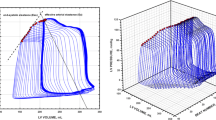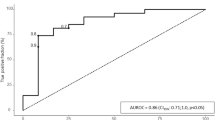Summary
The peak-systolic pressure end-systolic diameter relationship (PSPESDRS) was determined in ten healthy subjects under general anaesthesia by using the radial artery pressure tracing (peak-systolic pressure) and transoesophageal 2d-and m-mode echocardiography (left ventricular diameters) without blocking of autonomic reflexes. Left ventricular load was changed by injection of a single intravenous dose of 0,2 mg nitroglycerin (NTG). Linear regression analysis showed a close linear relationship during the pressure decrease between peak-systolic pressures and end-systolic diameters.
During infusion of dobutamine 5 μg/kg/min there was also a close linear relationship during pressure decrease with increased slope and unchanged Do (D0=diameter at theoretical pressure zero). Values taken during pressure returning to control level were shifted leftward indicating transient increased contractility.
We conclude, that the PSPESDRS can reliably be measured in humans without autonomic blockade during the decrease of arterial pressure after NTG, where reflex changes in inotropy are not yet present. This relationship increases in slope with dobutamine, reflecting the increased contractile state.
Similar content being viewed by others
References
Borow KM, Neumann A, Wynne J: Sensitivity of end-systolic pressure-dimension and pressure-volume relations to the inotropic state in humans. Circulation 65: 988, 1982.
Bow ditch HP: Über die Eigenthümlichkeiten der Reizbarkeit, welche die Muskelfasern des Herzens zeigen. Arbeiten aus der Physiologischen Anstalt zu Leipzig. In: Berichte der Ges d Wiss zu Leipzig math physt: CL 652, 1871.
Davidson DM, Covell JW, Malloch CJ, Ross R: Factors influencing indices of left ventricular contractility in the dog. Cardiovasc Res 8: 299, 1974.
Gilber BW, Hew EM: Physiologic significance of hemodynamic measurements and their derived indices. CMA Journal 121: 871, 1979.
Grossman W, Braunwald E, Maun T, Mc Laurin LP, Green LH: Contractile state of the left ventricle in man as evaluated from end-systolic pressure-volume relations. Circulation 56: 845, 1977.
Heinrich H, Fontaine L, Fösel Th, Spilker D, Winter H, Ahnefeld FW: Vergleichende echokardiographische Untersuchungen zur negativen Inotropie von Halothan, Enfluran und Isofluran. Anaesthesist 35: 465, 1986.
Hillel Z, Thys D, Goldman ME, Salek M, Kaplan JA: Intraoperative measurement of the effects of dopamine on LV contractility. Anesthesiology 63: A 25, 1985.
Hirshleifer J, Crawford M, O’Rourke RA, Karliner JS: Influence of acute alterations in heart rate and systemic arterial pressure on echocardiographic measures of left ventricular performance in normal humans subjects. Circulation 52: 835, 1975.
Kass DA, Yamazaki T, Burkhoff D, Maughan WL, Sagawa K: Left ventricular end-systolic pressure-volume relationships by the conductance (volume) catheter technique. Circulation 73: 586, 1986.
Koch-Weser J, Blinks JR: The influence of the interval between beats on myocardial contractility. Pharmacol Rev 15: 601, 1963.
Little WC, Freeman GL: Effect of nitroprusside and angiotensin II on the left ventricular end-systolic pressure-volume relation in closed chest dogs. Circulation 70, Supp II: II-236 (Abstract), 1984.
Mahler F, Yoran C, Ross R: Inotropic effect of tachycardia and poststimulation potentiation in the conscious dog. Am J Physiol 227: 569, 1974.
Mahler F, Covell JW, Ross R: Systolic pressure-diameter relations in the normal conscious dog. Cardiovasc Res 9: 447, 1975.
Marsh JD, Green LH, Wynne J, Cohn PF, Grossman WC: Left ventricular end-systolic pressure-dimension and stress-length relations in normal human subjects. Am J Cardiol 44: 1311, 1979.
Maughan WL, Sunagawa K, Burkhoff D, Sagawa K: Effect of arterial impedance changes on the end-systolic pressure-volume relation. Circ Res 54: 595, 1984.
Monroe RG, Gamble WJ, La Farge CG, Stark HJ, Sanders GL, Phornphutkul C, Davis M: The Anrep effekt reconsidered. J Clin Invest 51: 2573, 1972.
Noble MJM: Left ventricular load, arterial impedance and their interrelationships. Cardiovasc Res 13: 183, 1979.
Sagawa K: The end-systolic pressure-volume relation of the ventricle: Definition, modifications and clinical use. Circulation 63: 1223, 1981.
Scher AM: Carotid and aortic regulation of arterial blood pressure. Circulation 56: 521, 1977.
Suga H, Sagawa K, Shoukas AA: Load independence of the instantaneous pressure-volume ratio of the canine left ventricle and effects of epiuephrine and heart rate on the ratio. Circ Res 32: 314, 1973.
Suga H, Hisano R, Goto Y, Yamada O: Normalization of end-systolic pressure-volume relation and Emax of different sized hearts. Jap Circ J 48: 136, 1984.
Tuttle RR, Mills J: Development of a new catecholamine to selectively increase cardiac contractility. Circ Res 36: 185, 1975.
Vatner SF, Higgins CB, Millard RW, Franklin D: Direct and reflex effects of nitroglycerin on coronary and left ventricular dynamics in conscious dogs. J Clin Invest 51: 2872, 1972.
Vatner SF, Monroe RG, Mc Ritchie RJ: Effects of anesthesia, tachycardia, and autonomic blockade on the Anrep effect in intact dogs. Am J Physiol 226: 1450, 1974.
Vatner SF, Braunwald E: Cardiovascular control mechanisms in the conscious state. New Engl J Med 293: 970, 1975.
Author information
Authors and Affiliations
Rights and permissions
About this article
Cite this article
Heinrich, H., Fösel, T., Fontaine, L. et al. Assessment of contractility changes in humans by transoesophageal echocardiography: The peak-systolic pressure end-systolic diameter relationship (PSPESDRS). J Clin Monit Comput 4, 243–248 (1987). https://doi.org/10.1007/BF02915865
Accepted:
Issue Date:
DOI: https://doi.org/10.1007/BF02915865




